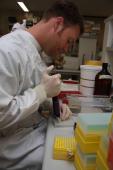Complete
This project was an extension of an earlier scoping project CRC30014 that developed software to collect surveillance data via small personal digital assistants (PDA) devices.
The software developed enhances the conformity and integrity of data collected during urban surveillance activities.
There were two central aims of the second phase project. The first was the delivery of the urban surveillance software to a greater number of surveillance personnel as well as mapping the best method for the integration of collected data into national initiatives such as The Australian Biosecurity Intelligence Network (ABIN) and Biosecurity Surveillance Incident Response and Tracing (BioSIRT).
The second aim of the project was to provide the post-harvest grains industry with a system to digitally collect and collate all grains pests surveillance information (presence/absence of emergency plant pests (EPPs), resistance to phosphine and fumigation/treatment records).
The project introduced a system that provides for seamless digital collection and collation of all surveillance related biosecurity information for the post-harvest grains industry. The system has built in checks to ensure data integrity and it is proposed that collected data may also directly interface with BioSIRT. This means it has the capacity to easily interface with other compliant (national and other) systems and also provides a development path into the future, which could include initiatives like ABIN.
This project allows the rapid and efficient use of all surveillance data to maintain and protect markets for the Australian grains and potentially other agricultural/horticultural industries.
Research outcomes:
PDA Phase Two project successfully developed and deployed six main applications:
- Biosecurity hazard site surveillance
- Multi-pest surveillance (MPS, BioSIRT compatible)
- Khapra beetle surveillance
- Forest plantation pest surveys (IPMG)
- MyPestGuide mobile pest datasheets
- Urban plant pest surveillance (USDB)
- Dermestid surveillance
- Stored grain ecology studies
- European wasp surveillance
- Exotic dung beetle surveys
- Locust surveys
- Tramp ant surveys
The Urban Surveillance Database was built with generic plant biosecurity surveillance in mind and has been adapted for a number of diverse projects. It services the popular need for recording property and contact details, one-is-to-many geo-located and barcoded activities (including digital image), one-is-to-many inspections of activities, one-is-to-many specimen details can be added with barcoded specimen labels and photograph.
Field-collected data are synchronised (two-way data transfer) from anywhere in the world via GPRS, WiFi to a wireless server hosted at DAFWA where it is available for further analysis and reporting.
Smartphone pest identification tools have become popular and can be used in conjunction with USDB to ensure rapid field recognition of potential Emergency Plant Pests. This project developed two database-driven smartphone apps (MyPestGuide & PestWeb Mobile). Individual pest records are added on the wireless server and pushed out to devices. These smartphone identification tools can be deployed as a shell for overseas users, or pre-populated with quarantine pests of significance.
Collaboration with CRC for Forestry resulted in development of the mobile software solution, called IPMG Plantation Health. This software allows foresters to quickly and accurately record pest and disease outbreaks in the field, including; the date of the observation, the extent and severity of any damage caused, GPS co-ordinates and photos. The software also includes brief weed and pest field guides to aid foresters with correct identification in the field.
Research implications:
A high proportion of Australia’s agricultural produce is exported and demonstration of freedom from certain plant pests and diseases is critical to maintaining and securing new market access opportunities. Pest surveillance is an important tool for market access and accordingly importing countries now demand accurate, credible evidence to confirm pest freedom status.
In the past nearly all field-collected plant biosecurity surveillance information was recorded manually to paper reducing the rate of capture, integrity, conformity as well as security of the data. There is a growing need for plant pest surveillance data collection software and hardware that uses smartphones to provide auditing validation, ‘chain of evidence’ as well as increasing the volume of data collected and its integrity through relational databases and seamless data transfer to corporate systems. Smartphone data integrity is supported by GPS-located traps, digital voice navigation itineraries, time and date stamps, field printed barcode labels, site and pest imagery.
Pest identification tools delivered via smartphones are an important tool that allows immediate identification of potential biosecurity threats in the field.
Acknowledgements:
The following CRCNPB participants provided constructive criticism during development of the applications; Michelle Chami, David Cousins, Oonagh Byrne, Marc Widmer, Richard Johnston, Mike Grimm, Peter Gillespie, Deborah Kent, Cain Roberts, Paul Pheloung, Greg Hood, Steve Pratt and Deb Riddell.
Brian McCornack (KSU), Gordon Gordh (USDA) provided a useful US perspective.
Francisco Tovar (CRC Forestry/ Murdoch University) designed the IPMG application. Peter Davis demonstrated the potential for USDB in ant surveys on Barrow Island.
PROJECT LEADER

Assoc Prof Giles Hardy
Project Leader CRC70085: Personal Digital Assistants (phase two)
g.hardy@murdoch.edu.au
Phone: 08 9360 6272
Fax: 08 9360 6303
Read More
PROJECT DETAILS
Complete
Term
July 2009 – April 2012
Budget
$1,371,600 (cash and in-kind support)
PROGRAM DETAILS
LOCATION
Airport Forensics was a joint project with Grains Research and Development Corporation (GRDC). This project defined the plant pathogen incursion risk posed by people returning from overseas and interstate travel. This was achieved through the development of technically sound sample/survey methodologies.
The project initially focused on cereal rusts. An assessment of the level of human mediated rust entries into Australia was determined through the sampling of travellers who have been known to have visited grain production regions overseas. Pathogen types examined included air-borne pathogens such as rusts and powdery mildews, and soil-borne pathogens such as Fusarium wilt.
The project also increased the awareness and education of both international and domestic travellers about the risks of spreading plant pathogens on hair, clothing and footwear if they are not cleaned appropriately.
Research outcomes:
A forensic kit was developed that can be used by field staff and international travellers for testing their clothing for the presence of fungal spores. The protocol developed for processing the kit has a > 85% extraction efficiency rate.
The physical properties of fabric that are used to make clothes influence the donor and recipient properties of the clothes. This refers to the ability of the clothes in collecting spores, carrying them and releasing them. Experimental work demonstrated that there is an interaction between spore morphology and the type of fabric.
Experimental work demonstrated that washing the fabric does not remove all of the spores that are present in or on the fabric.
Samples from DAFWA staff that had been working in the field were collected and processed. Samples were also collected from field staff working in NSW, QLD and SA. These samples were processed using the above protocol and then split into three subsamples for analysis. The analysis was done by microscopy, PCR and mass spectrometry.
The use of mass spectrometry to identify fungal spores was successfully demonstrated. Eighteen different fungal pathogens were tested and then identified using blind samples.
The development of a real-time multiplex PCR for the detection of wheat, stem and stripe rust was used successfully to detect and identify these rusts on staff that had been working in the field. There was a reasonable correlation between the microscopy results and the PCR results. The use of mass spectrometry on these samples was not successful due to the low number of spores present in the samples.
Samples were collected from GRDC travel scholarship recipients. The results showed that fungal spores were detected and identified using microscopy and PCR methods.
The research has shown that clothing can realistically provide a pathway for the introduction of fungal pathogens into Australia and within Australia. However, the viability of these spores are not known and will need to be determined.
Research implications:
The research implications from this scoping study, is that awareness of this pathway needs to be raised and does exist. Further work needs to be done to clarify the risk associated with this pathway.
Results from this work have been presented at Global Biosecurity Conference in Brisbane in 2010, and the CRCNPB Science Exchange in Barossa Valley in 2011.
Two refereed publications will be submitted by June 2011.
Numerous articles of the work have been published in the press and in the GRDC GroundCover Biosecurity supplement.
Acknowledgements:
The team would like to thank GRDC and the CRCNPB for supporting and funding such an interesting project.
We would also like to thank Ms Alana Wilkes for her hard work on the mass spectrometry work. Mrs Mirjana Banovic, Mrs Annette Bwye, and Mrs Val McGann for the processing of the forensic tape samples for analysis.

Photo caption: Forensic kit provided to travellers to test for fungal spores on clothing.
Photo acknowledgement: The Department of Agriculture and Food, Western Australia
This is a joint research project with Grains Research and Development Corporation.
PROJECT LEADER
Ms Dominie Wright
Project Leader CRC40142: Airport Forensics
dominie.wright@agric.wa.gov.au
Phone: 08 9368 3875
Fax: 08 9474 2840
Read More
PROJECT DETAILS
Complete
Term
June 2009 – December 2010
Budget
$1,215,282 (cash and in-kind support)
PROGRAM DETAILS
Resistance to phosphine in target pests threatens market access for Australian grain. While the grains industry is now attempting to develop an effective and sustainable strategy to manage this resistance, action is severely limited by significant gaps in our knowledge of the key ecological factors that influence the development of resistance. There is a need to research this information as a foundation for a rational approach to managing phosphine resistance in the Australian grains industry.
Research outcomes:
The project has provided critical research methodologies and preliminary data to fill the large gaps in our knowledge of the ecology of two key pests, Rhyzopertha dominica and Tribolium castaneum, and how this may drive the development of phosphine resistance. This information will contribute to the groundwork for future research needed to provide a scientific basis for a rational resistance management strategy.
Research implications:
The project had a heavy emphasis on field research and the largest effort went to pheromone-trapping programs in two grain growing districts. Trapping showed that beetles of both species were caught across much of the rural landscape especially during the warmer months when grain is harvested and placed into storage. Despite some differences between study areas and species, the results show that infestation pressure is high for a considerable period of the year.
Beetles were trapped near farm silos, in paddocks and in natural vegetation, sometimes 5-10 km from the nearest farm. Unless evidence emerges that these beetles are exploiting resources other than stored grain and grain products, the data suggest considerable movement in the rural landscape. Population genetics analysis of the frozen trap catches may give some insights into movement on a larger scale, but field experimentation is likely to be required to understand movement on a finer scale.
Knowledge of the phosphine resistance status of trapped beetles is essential to understanding resistance development outside of the immediate storage environment, and therefore potential resistance management options. Molecular markers would be best for this purpose but bioassay data from Queensland detected no differences between beetles trapped in paddocks or near silos.
There are many studies on the survival and reproductive characteristics of R. dominica and T. castaneum under controlled and often ideal conditions, but there is a need to characterise wild beetles of both species. Experiments on individual adults emigrating from infested farm silos showed that most females had mated before emigrating and were capable of reproduction for many weeks without further mating. These results show the colonising potential of these species, and have implications for resistance development.
Growers and other who store grain should take all measures needed to minimise the likelihood of infestations in stored grain bulks, including hygiene, inspecting grain and aeration cooling and chemical control. The project demonstrated heavy infestation pressure from R. dominica and T. castaneum for lengthy periods during the year, and the results to date suggest considerable movement of beetles across the rural landscape.
Acknowledgements:
We are grateful to the many growers and their families who allowed access to their properties for the research.
PROJECT LEADER
Dr Greg Daglish
Project Leader CRC50089: Grain Insect Ecology
greg.daglish@deedi.qld.gov.au
Phone: 07 3896 9415
Fax: 07 3896 9446
Read More
PROJECT DETAILS
Complete
Term
July 2007 – December 2009
Budget
$3,563,414 (cash and in-kind support)
PROGRAM DETAILS
CORE CRC PARTICIPANTS
CONTRIBUTORS
Rapid response is crucial to minimising the cost of an incursion of an invading pest/disease organism. An essential part of a rapid response is an effective surveillance strategy, and central to effective surveillance is knowing where to look. This requires a rapid assessment of the organism potential to spread in the environment where it has been found. The outcome of this project will help managers to quickly marshal all available biological information to forecast spread of a new pest or disease.
Research outcomes:
This project developed a framework that will improve our ability to successfully respond to new incursions of emergency plant pests. Spread predictions are made by integrating information provided by experts into a General Model of Biological Invasion (GMBI). We have shown that the framework is general enough to characterise, simulate and make reasonable predictions for a wide range of organisms (including vertebrate and invertebrate animals, plants, fungal and bacterial pathogens, and even viruses spread by insect vectors) in a wide range of landscapes (including urban, peri-urban, rural and natural environments).
Research implications:
The General Model of Biological Invasions (GMBI) framework developed in this project provides a valuable tool for managing organisms that are known to be high risk, that have just arrived and that need to be dealt with as quickly and effectively as possible.
PROJECT LEADER
Dr Michael Renton
Project Leader CRC10124: Forecasting Spread for Rapid Response
michael.renton@uwa.edu.au
Phone: 08 6488 1959
Read More
PROJECT DETAILS
Complete
Term
Feb 2009 – May 2012
Budget
$1,142,389 (cash and in-kind support)
PROGRAM DETAILS
CORE CRC PARTICIPANTS
SUPPORTING CRC PARTICIPANTS
There is a need to develop technologies that can be used to rapidly detect and quantify pest infestations in bulk grain to assist in the management of these biosecurity threats. This project identified and characterised pheromone receptors in the genome of Tribolium castaneum, common insect pest of stored grain.
Research outcomes:
The experimentally derived information regarding the proteins involved in the perception of the T. castaneum produced volatile DMD, will aid in the development of a biosensor platform for the detection of this stored grain insect. The key information uncovered during the course of this project included:
- Adult and larvae T. castaneum respond to infested flour more than clean flour.
- Both adults and larva respond behaviourally to DMD with female adults displaying the highest sensitivity to the compound.
- The antennae of T. castaneum responded to four beetle odours, including the aggregation pheromones for Rhyzopertha dominica and itself, but only its own pheromone caused a significant behavioural response.
- Male beetles express at least three receptors at higher levels than females, and females express at least one receptor more highly than males. These are candidate pheromone receptors.
- Insect Sf9 cells are not suitable for the expression and characterisation of T. castaneum olfactory receptors using calcium influx assays.
- The OBPs we expressed and purified are capable of solubilising (which indicates direct binding to) DMD, and therefore also make good candidates for use in a biosensor platform.
Research implications:
- The implication of finding putative pheromone receptors of the stored grain pest, T. castaneum, means we have candidates for the biorecognition component of a biosensor device.
- The development of a grain pest biosensor would allow greater control and efficiency for grain pest management applications. This would facilitate the maintenance of access to export markets and minimise the level of phosphine-resistance in stored grain pests, which is a key threat to market access.
- Capabilities developed through the course of this project can potentially be applied to other stored grain pests, and indeed, to other applications requiring monitoring of volatiles.
Acknowledgements:
- Sylwek Chyb
- Trécé Inc. (Oklahoma, USA)
- Professor Cobb, University of Manchester
- Dr Tamara Cooper (SARDI Entomology) for her technical expertise and help in the expression and purification of the OBPs
- CSIRO staff and students - Cécile Faucher; Lijun Cai; Stephen Trowell; Amalia Berna; Michelle Michie; Thomas Wallenius; James Darby; Wolf Wanjura
PROJECT LEADER

Dr Alisha Anderson
Project Leader CRC20081: Biosensor-based Detection of Grain Pests
Alisha.Anderson@csiro.au
Phone: +61 2 6246 4181
Read More
PROJECT DETAILS
Complete
Supervisor
Deb Hailstones
Term
May 2009 – May 2012
Budget
$1,020,322 (cash and in-kind)
PROGRAM DETAILS
LOCATION
INDUSTRY RELATED
As part of phase two of our Insect Eradication project this research further refines the recommended techniques used against moth pests culminating in field verification trials against Light Brown Apple Moth (LBAM) in urban and orchard areas.
The aim of the project was to investigate the integration of innovative eradication technologies against LBAM as a model for the development of eradication strategies against other exotic moth pests. The main objective was the integration of the sterile insect technique and mating disruption using novel pheromone distribution technologies such as mobile mating disruption and SPLATTM (Specialized Pheromone and Lure Application Technology) in urban areas and vineyards.
Research outcomes:
Identification of irradiation dose for SIT, development and testing of mobile mating disruption, development and testing of SPLATTM in SA, NZ and WA, testing of integrated eradication in the field (SPLATTM + insecticide) and urban environment (SPLATTM +SIT), analysis of past eradications in Australia.
Transfer of technologies such as SPLATTM for eradication of pests from other insect orders needs to be investigated. Improvement in eradication efficiency through the development of mechanised application technology and improved formulation is highly likely with further input. Further research is required to develop softer eradication technologies for use in urban areas that can be integrated with pheromones.
Research implications:
New pheromone delivery technologies such as SPLATTM have the potential to become an important component of integrated eradication strategies in the future.
Acknowledgements:
The support of Jane Moran and David Eagling for Phase 1 and Phase 2 of the project is acknowledged.
PROJECT LEADER

Mr Bill Woods
Project Leader CRC40136: Insect Eradication (Phase two)
bwoods@agric.wa.gov.au
Phone: 08 9368 3962
Fax: 08 9368 3195
Read More
PROJECT DETAILS
Complete
Term
April 2009 – April 2012
Budget
$1.1 million (cash and in-kind support)
PROGRAM DETAILS
LOCATION
CORE CRC PARTICIPANTS
CONTRIBUTORS
As part of phase two of our Pathogen Eradication Strategies project, we developed alternative strategies to optimise the eradication process and minimise the economic cost of returning the crop to its previous quality and production.
Research outcomes:
- An eradication protocol based on drastic pruning has been developed and validated for use on grapevines in the event of an incursion of the fungal disease, black rot (Guignardia bidwellii).
- A decision reference tool for consideration of non-destructive eradication to guide scientific assessment panels convened as part of consultative committees during incursions of perennial plant pathogens.
- Burning infected grapevine and pistachio material will eliminate Elsinoe ampelina and Xanthomonas translucens pv. pistaciae, respectively, if all material is completely burnt. X. translucens may survive on unburnt and buried wood for more than two years.
Research implications:
- The eradication protocol based on drastic pruning may be effective for other exotic pathogens of grapevines and other perennial crops but each will require validation before inclusion in Industry Biosecurity Plans.
- Completely burning infected grapevine and pistachio plant material will eliminate fungal and bacterial pathogens; further research is required to develop protocols for effective burns on different host plant material. Pathogens may survive in unburnt and buried material for more than two years so soil must remain undisturbed for three or more years.
Acknowledgements:
- South Australian Research and Development Institute
- Department of Primary Industries, Victoria
- Cornell University
- University of Adelaide
- B3 New Zealand
- The Department of Primary Industry, Fisheries and Mines, Northern Territory
PROJECT LEADER
Dr Mark Sosnowski
Project Leader CRC40139: Pathogen Eradication Strategies (Phase two)
mark.sosnowski@sa.gov.au
Phone: 08 8303 9489
Fax: 08 8303 9393
Read More
PROJECT DETAILS
Complete
Term
July 2006 – June 2011
Budget
$1,280,700 (cash and in-kind support)
PROGRAM DETAILS
LOCATION
CORE CRC PARTICIPANTS
SUPPORTING CRC PARTICIPANTS
This project was created as there was a need to develop simple and accurate diagnostics to rapidly distinguish Khapra beetle from its close relatives. The aim of this project was to enhance the capacity to effectively and efficiently identify this species, especially in identifying the highly problematic and particularly difficult larval stages. The development of a broader range of skills and techniques provided much needed support to existing diagnosticians and taxonomists.
What is the biosecurity problem?
The genus Trogoderma (Grain beetles) contains some of the world's most serious economic pests of wheat and other stored grain products. Even with application of strict quarantine measures, these grain beetles still find their way into new countries. This causes imposition of unfavourable restrictions on exports. It is estimated that the total Australian export revenue at risk by an established Trogoderma granarium (Khapra beetle) infestation is over $1.83 billion annually (mainly attributed to the loss of Pest Freedom status) a scenario that would be detrimental to both the grains industry and the Australian economy.
The outputs of this project were to:
- train a PhD student in taxonomy and molecular diagnostics
- conduct a phylogeographic study (a study of geographical distribution of the pest over time) on the three exotic, one introduced and as many as possible of the 52 described native non pest Trogoderma
- conduct a phylogenetic study (evolutionary relatedness) on Trogoderma species, and closely related beetles in the family Dermestidae
- develop an accurate Polymerase Chain Reaction (PCR) method for detecting Trogoderma pest species, and
- investigate the use of protein analysis using mass spectrometry to differentiate selected species.
Who will be the end - users of this research?
Technical Officers and Quarantine inspectors.
STUDENT
PROJECT DETAILS
Complete
Supervisor
Professor David Groth, Dr Kylie Munyard (Curtin Univesity), Mr Andras Szito (DAFWA), Dr Glynn Maynard (DAFF) and Dr Andrew Baker (QUT)
Supervising Institution
Curtin University, QUT and DAFWA
Term
December 2007 - December 2010
LOCATION
New and emerging industries have a unique opportunity to establish good biosecurity at an integral stage of the development of an industry. This would allow best practices to be established amongst growers early in the life of the industry and benefit the industry as it expands. Yet such industries also have the unique challenge that at this stage of evolution, their limited resources may reduce their ability to undertake biosecurity communication activities.
Research outcomes
The outcomes of this research include the development of a national plant health communications strategy framework and toolkit aimed at enhancing biosecurity awareness and behaviours across Australia’s plant industries.
The communications strategy framework highlights the effective strategies and elements used in previous biosecurity communications campaigns. It then recommends activities that could be adapted for use in future biosecurity communications and campaigns in the plant industry. Some of these recommendations include improved coordination and evaluation of communication activities, efforts to engage ‘gap’ audiences and research to better understand the barriers, drivers and incentives affecting the uptake of biosecurity practices.
The Plant Industry Biosecurity Communications Toolkit has been developed from this report to assist industry organisations plan future communications activities.
Research implications
It is readily apparent that right across the plant sector, and at all levels (from Federal and State Governments to national, state and local industry levels) there is a wide range of communication activities earnestly attempting to address the key issues of firstly raising biosecurity awareness (either reactively or proactively), and secondly, promoting behavioural change by farmers and communities.
However, it is also readily apparent that these activities are not broadly coordinated at the industry and state agency level. This creates an environment where possible duplication, inconsistency and lack of planning can occur in communications/campaign construction, stakeholder engagement and messaging. Also, maximal usage of available resources and materials and learning from previous campaigns is not necessarily undertaken within, among or between industries and agencies.
It is suggested that this scenario can be addressed by a national body actively working with various industries and agencies, and providing agreed tools and resources (the communications framework and toolkit) to streamline and underpin common approaches. Such a body can also play a lead role to address issues to do with gap audiences, leveraging of government resources, and providing consistent high level communications products and biosecurity intelligence.
Acknowledgements
Marie Bracks-Burns (Department of Agriculture and Food, Western Australia), Amity Sturwohld (Queensland Primary Fisheries and Fisheries) and Dr Ryan Wilson (Plant Health Australia)
PROJECT LEADER

Mr Jim McGrath
Project Leader CRC70036: National Communication Strategy Framework
jmcgrath@phau.com.au
Phone: 02 6260 4322
Read More
PROJECT DETAILS
Complete
PROGRAM DETAILS
LOCATION
This project will provide a mathematical framework from which future management strategies on phosphine fumigation of Rhyzopertha dominica can be derived, with consideration of the species' increasing genetic resistance to phosphine.
What is the biosecurity problem?
Phosphine resistance of Rhyzopertha dominica
(Coleoptera: Bostrichidae).
The outputs of this project are to:
- develop an understanding of the significance of the differences between resistance occurring on one gene compared to two genes for the emergence of resistance
- develop a preliminary software tool for assessing different fumigation strategies, and
- train an honours student in insecticide resistance modelling in the postharvest system, with the view to developing the skills necessary to do a PhD in this area.
Who will be the end-user of this research?
Bulk handlers are the major end uses of the project, although any stakeholder that stores grain will benefit from the research developed in the project. Stored product researches will also benefit from insights delivered by the project.
STUDENT
PROJECT DETAILS
Complete
Supervisor
Dr Glenn Fulford (QUT), Dr Andrew Ridley (DPI&F), Dr David Schlipalius (DPI&F)
Supervising Institution
Queensland University of Technology
Term
July 2008 – July 2009




















